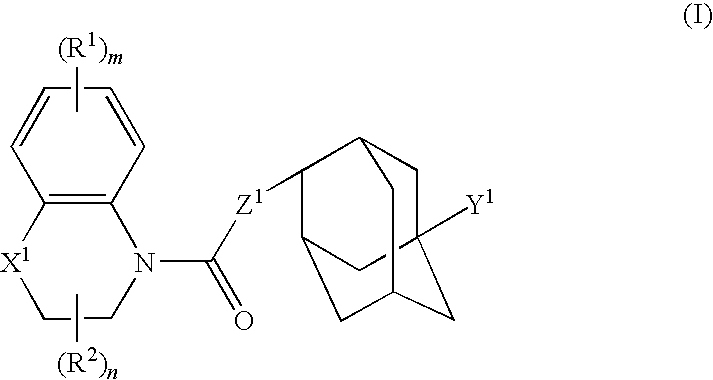Compound having 11beta-hsd1 inhibitory activity
a technology of hsd1 inhibitors and compounds, which is applied in the field of compounds, can solve the problems that the 11-hsd1 inhibitors cannot exert sufficient activity, and achieve the effect of excellent 11-hsd1 inhibitory activity
- Summary
- Abstract
- Description
- Claims
- Application Information
AI Technical Summary
Benefits of technology
Problems solved by technology
Method used
Image
Examples
reference example 1
Synthesis of E-4-aminoadamantan-1-ol hydrochloride
[0092]To a solution of 5-hydroxy-2-adamantanone (10.2 g) in 8M ammonia (in methanol, 50 ml), 10% palladium on activated carbon (1.00 g) was added and stirred under a hydrogen atmosphere at room temperature for 15 hours. After the reaction mixture was filtered, the solvent was distilled off under reduced pressure and the resulting residue was purified by NH silica gel column chromatography (eluting solvent: chloroform alone→chloroform:methanol=9:1) to give 4-aminoadamantan-1-ol (10.2 g, E-form:Z-form=4:1). 4-Aminoadamantan-1-ol thus obtained (10.2 g) was dissolved by heating in tetrahydrofuran (50 ml), and 4M hydrochloric acid (in 1,4-dioxane, 20 ml) was added thereto, followed by stirring at room temperature for 16 hours. The precipitated solid was collected by filtration to give 4-aminoadamantan-1-ol hydrochloride (12.1 g, E-form:Z-form=4:1). The resulting E / Z mixture (9.15 g) was dissolved by heating in ethanol (450 ml) and water (...
reference example 2
Synthesis of E-4-aminoadamantan-1-ol
[0094]E-4-Aminoadamantan-1-ol hydrochloride obtained in Reference Example 1 (3.60 g) was dissolved in water (20 ml) and adjusted to pH 12 by addition of 2.5M aqueous sodium hydroxide (12 ml) under ice cooling. After extraction six times with chloroform, the combined organic layers were dried over anhydrous magnesium sulfate and then filtered to remove the desiccant, followed by distilling off the solvent under reduced pressure. The resulting residue was converted into a powder form by addition of n-hexane, and then collected by filtration to give the titled compound, i.e., E-4-aminoadamantan-1-ol (2.94 g) as a colorless powder.
[0095]1H NMR (300 MHz, DMSO-D6) δ 1.09-1.26 (m, 2H), 1.47-1.77 (m, 9H), 1.86-2.00 (m, 3H), 2.78-2.85 (m, 1H).
reference example 3
Synthesis of 5-fluoro-2,3-dihydro-1H-quinolin-4-one and 7-fluoro-2,3-dihydro-1H-quinolin-4-one
[0096]To 3-fluoroaniline (5.0 g), water (50 ml) and acrylic acid (3.6 g) were added and heated under reflux for 3 hours. After cooling to room temperature, the reaction mixture was stirred for 3 days and further heated under reflux for 7 hours. After cooling at room temperature, the solvent was distilled off under reduced pressure. To the resulting residue, 8M aqueous sodium hydroxide and chloroform were added to separate the aqueous layer. The separated aqueous layer was adjusted to pH 3 with 12M aqueous hydrochloric acid under ice cooling, and then extracted with chloroform. The extracted organic layer was dried over anhydrous magnesium sulfate and then filtered to remove the desiccant, followed by distilling off the solvent under reduced pressure. The resulting residue was purified by silica gel column chromatography (eluting solvent: n-hexane:ethyl acetate=4:1) to give 3-[N-(3-fluorophe...
PUM
 Login to View More
Login to View More Abstract
Description
Claims
Application Information
 Login to View More
Login to View More - R&D
- Intellectual Property
- Life Sciences
- Materials
- Tech Scout
- Unparalleled Data Quality
- Higher Quality Content
- 60% Fewer Hallucinations
Browse by: Latest US Patents, China's latest patents, Technical Efficacy Thesaurus, Application Domain, Technology Topic, Popular Technical Reports.
© 2025 PatSnap. All rights reserved.Legal|Privacy policy|Modern Slavery Act Transparency Statement|Sitemap|About US| Contact US: help@patsnap.com



